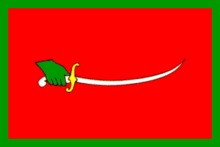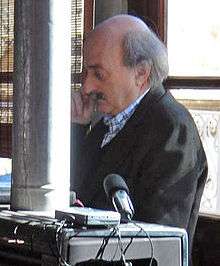Jumblatt family
The Jumblatt family (Arabic: جنبلاط, originally Kurdish Canpolad جانپولاد, meaning "steel-bodied" or "soul of steel"),[1] also transliterated as Joumblatt, Junblat and Junblatt) is a Kurdish family who settled in the Lebanon mountains (coming from Syria) around the 15-16th century, fleeing persecution from an Ottoman governor. Tradition holds the Jumblatt family to be the leaders of the Kaysi Arabs, who fought a bitter war with the Yemeni Druze in the Battle of Ain Darra of 1711. Although Lebanese Druze leader Walid Jumblatt is the most known and influential figure of the family in modern Lebanon, there are other Jumblatt family members from this lineage who contribute to the cultural, economic and social life in Lebanon, and not restricted to the Chouf and Mount Lebanon, but also having a visible presence in mansions and villas within the distinguished Clemenceau area of Beirut and in the north-west area of Sidon.
History

Kamal's own father, Fouad Jumblatt, was himself assassinated on August 6, 1921.
Kamal Jumblatt was a respected political leader. Allegedly, on his bedroom wall he had pictures of Jesus and Mahatma Gandhi. He was a rebellious figure and despite his descent from an aristocratic family, he supposedly lived a simple life neglecting the wealthy lifestyle that other political figures had at the time. Kamal Junblat was well-educated and quite attracted by the arcanes of Far Eastern philosophy; he wrote many books, touching on diverse subjects including philosophy, spirituality, and macrobiotics. It is said that he embraced meditation and practiced it often.
Jumblatt played a role in Lebanese history. Mrs. Nazira Jumblatt (mother of Kamal) kept the dynasty alive, in a time when it was hard for women to play a political role. Before that, Sheikh Bashir Jumblatt was assassinated, during times of confrontation with the prince Bashir II, where a saying had spread at the time: El Chouf ma betse bashirein, which means the Chouf province cannot handle two opposing leaders... In addition, Khaled Jumblatt, a distant cousin of Walid Jumblatt, held the position of minister of economy and was a prominent politician in Lebanon for many years until his death in 1993.
Modern
Today, Walid Jumblatt is a prominent Lebanese politician and the leader of the Druze of Lebanon (an influential religious community found in the Arab World, specifically in Lebanese politics). His son, Taymoor, is being prepared to follow his father's footsteps in the political scene in the future. After the assassination of the Lebanese prime-minister Rafik Al-Hariri, Walid Jumblatt preemptively protected his children by sending them to France. Although Lebanese Druze leader Walid Jumblatt is the most known and influential figure of the family in modern Lebanon, there are other Jumblatt family members from this lineage who contribute to the cultural, economic and social life in Lebanon, and not restricted to the Chouf and Mount Lebanon, but also having a visible presence in mansions and villas within the distinguished Clemenceau area of Beirut and in the north-west upscale area of Sidon.
Cultural references
Samir Habchi's 2003 documentary film Lady of the Palace examines the history of the Jumblatt family from the 17th century onwards. The film focuses on the life of Nazira Jumblatt and the late nineteenth/early twentieth century.[2]
References
- Dictionary of Modern Arab History, p. 219, at Google Books
- "Lady of the Palace." https://www.imdb.com/title/tt0794307/. Retrieved 22 August 2013.
